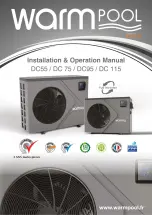
4
4. Refrigerant piping work
4.1. Refrigerant pipe (Fig. 4-1, Fig. 4-2)
► Check that the difference between the heights of the indoor and outdoor
units, the length of refrigerant pipe, and the number of bends in the pipe
are within the limits shown below.
Models
A
Pipe length
(one way)
B
Height
difference
C
Number of
bends (one way)
SUZ-KA09, KA12,
KA15
Max. 65 ft (0 m)
Max. 40 ft (1 m)
Max. 10
SUZ-KA18
Max. 100 ft (30 m)
Max. 50 ft (15 m)
Max. 10
• Height difference limitations are binding regardless of which unit, indoor or out-
door, is positioned higher.
• Refrigerant adjustment ... If pipe length exceeds 25 ft. (7.5 m), additional refrig
-
erant (R410A) charge is required.
(The outdoor unit is charged with refrigerant for pipe length up to 5 ft. (7.5 m).)
Pipe length
Up to 5 ft (7.5 m)
No additional charge is required.
Exceeding 5 ft (7.5 m)
Additional charge is required.
(Refer to the table below.)
Refrigerant to
be added
SUZ-KA09, KA12, KA15
1.6 oz each 5 ft. (30 g/m)
SUZ-KA18
1.08 oz each 5 ft. (0 g/m)
• Table below shows the specifications of pipes commercially available.
Model
Pipe
Outside
diameter
Min. wall
thickness
Insulation
thickness
Insulation
material
inch (mm)
inch (mm)
inch (mm)
SUZ-KA09
For liquid
1/4 (6.35) 0.0315 (0.8)
5/16 (8)
Heat resisting
foam plastic
0.045 specific
gravity
For gas
3/8 (9.52)
0.0315 (0.8)
5/16 (8)
SUZ-KA12
For liquid
1/4 (6.35) 0.0315 (0.8)
5/16 (8)
For gas
3/8 (9.52)
0.0315 (0.8)
5/16 (8)
SUZ-KA15
For liquid
1/4 (6.35) 0.0315 (0.8)
5/16 (8)
For gas
1/ (1.7) 0.0315 (0.8)
5/16 (8)
SUZ-KA18
For liquid
1/4 (6.35) 0.0315 (0.8)
5/16 (8)
For gas
1/ (1.7) 0.0315 (0.8)
5/16 (8)
• To prevent condensation, insulate the refrigerant pipes.
• Refrigerant pipe bending radius must be 4 in. (100 mm) or more
Caution:
Be sure to use the insulation of specified thickness (table on the above). Excessive
insulation may cause incorrect installation of the indoor unit, and too little insulation
may cause condensate to form.
• The unit has flared connections on both indoor and outdoor sides.
• Remove the valve cover from the outdoor unit, then connect the pipe.
• Refrigerant pipes are used to connect the indoor and outdoor units.
• Be careful not to crush or over bend the pipe in pipe bending.
ø1/4 (6.35)
ø3/8 (9.52)
ø3/8 (9.52)
ø1/2 (12.7)
Fig. 4-1
Fig. 4-2
D
Indoor unit
E
Outdoor unit
A
Indoor unit
B
Outdoor unit
4.2. Flaring work (Fig. 4-3)
1) Cut the cooper pipe as straight as possible with a pipe cutter.
) Remove all burrs from the cut section of pipe, ensuring that precautions are
taken to avoid getting metal shavings into the piping.
3) Remove flare nuts attached to indoor and outdoor units, then put them on pipe.
4) Flaring work. Firmly hold copper pipe in the dimension shown in the table. Select
A inch (mm) from the table according to the tool you use.
5) Check
• Compare the flared work.
•
If flare is defective, cut off the section and repeat procedure.
Pipe diameter
inch (mm)
Nut
inch (mm)
A inch (mm)
Tightening torque
Clutch
type tool
for R410A
Clutch
type tool
for R
Wing nut
type tool
for R
N·m
ft·lb
(kgf·cm)
1/4 (6.35)
1/4 (17)
0 to 0.0
(0 to 0.5)
0.04 to
0.06
(1.0 to 1.5)
0.06 to
0.08
(1.5 to .0)
13.7 to 17.7 10 to 13
(140 to 180)
3/8 (9.52)
3/8 ()
34.3 to 41. 5 to 30
(350 to 40)
1/ (1.7)
1/ (6)
0.08 to
0.10
(.0 to .5)
49.0 to 56.4
36 to 4
(500 to 575)
5/8 (15.88)
5/8 (29)
73.5 to 78.4 54 to 58
(750 to 800)
Copper
pipe
Good
90°
Tilted
No good
Burr
Copper pipe
Spare reamer
Pipe cutter
Smooth all around
Even length
all around
Inside is shin-
ing without any
scratches.
A
Flare nut
Die
Copper pipe
Clutch type
Flaring tool
Wing nut type
Uneven Burred
Fig. 4-3





































